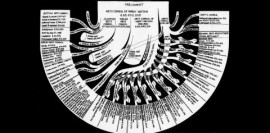
Understanding Turning Point
In this 2011 report Phyllida Shaw unwraps the ‘what’s what’ and ‘who’s who’ of Turning Point, a 10-year Arts Council England strategy for the visual arts.
In this 2011 report Phyllida Shaw unwraps the ‘what’s what’ and ‘who’s who’ of Turning Point, a 10-year Arts Council England strategy for the visual arts.
Is there enough funding going to individual artists and are the application processes user-friendly? These were questions a-n set out to answer in the fourth issue of what was then Artists Newsletter in 1980. Now, thirty one years later, we asked Dany Louise to do this research again, examining the current state of play for grants to individual artists as offered by Arts Council England, Arts Council of Northern Ireland, Arts Council of Wales and Creative Scotland – including comparators of volumes of artists applying and success rates – and to ascertain whether a “fair share” has been getting into the hands of artists to develop their practice.
In her report on Turning Point, Phyllida Shaw unwraps the ‘what’s what and who’s who’ of this major strategy for England, to support discussions on greater participation by, and development for, artists within it.
New high profile museums and galleries have opened across the UK, but how can they best contribute to the local arts and culture, asks Emily Speed.
Organisations around the UK facing cuts or closure.
New ways are needed to measure the types of value being delivered by small visual arts organisations, according to a new report looking at the role and value of the small-scale visual arts sector within the wider arts ecology.
This month’s bites.
What do festivals add to a city?
Report from the recent conference held in London.
A new report reveals that a disproportionate number of artists’ membership and development agencies and practice-based organisations lost core funding, despite ACE’s aim of creating a “balanced portfolio”.
The photographs of Sirkka-Liisa Konttinen and Amber’s films have been inscribed in the UNESCO UK Memory of the World Register as an archive of national cultural significance.
In this issue we continue to get a glimpse of how the visual and applied arts are developing new approaches in a harsher climate.
BECTU and other members of the Federation of Entertainment Unions (FEU) plus Connect and PCS held an event in June to launch the Lost Arts Campaign and website www.Lost-Arts.org.
New evidence exposing, quantifying and discussing the likely impact on the visual arts of Arts Council England’s decisions on fifteen previously Regularly Funded Organisations (RFOs) visual arts organisations unsuccessful in their NPO application. PDF file [200kbs]
Editorial published in Artists Newsletter in June 1991.
Funding for the arts has never been an easy sell – not with governments or the public. April Britski, Executive Director of CARFAC reports from Canada.
When the economic recession hit, it impacted on everything. But how in particular did it affect the livelihoods of artists in terms of access to employment and career opportunities, and what is the longer-term impact? [PDF version 153 kb]
Explores the affect of the economic recession on the livelihoods of artists in terms of access to employment and career opportunities and raises concerns about how artists’ practice is likely to fare in this period of arts austerity. [HTML format]
AHM (Sam Ainsley, David Harding and Sandy Moffat) presented the second of three one-day symposiums across Scotland in April.
In March, artists got together to discuss and share their strategies for surviving the cuts without compromising practice, ethics or professionalism.
a-n’s analysis of ACE’s new National Portfolio Organisations (NPO) for funding 2012-15.
Short sector commentary on Arts Council Wales review of revenue-funded clients in December 2010. Included as an early effect of the 2008 “credit crunch” and the resulting “austerity” programme which resulted in significant changes to cultural policy and cuts to arts funding across the UK.
Artists’ survival and growth is dependent on networking and professional interchange.
The majority of RFOs across art form have an annual income of less than
Given the voracious and swift nature of the cuts brought in by the current government, it is unsurprising that artists are already feeling the effects.















